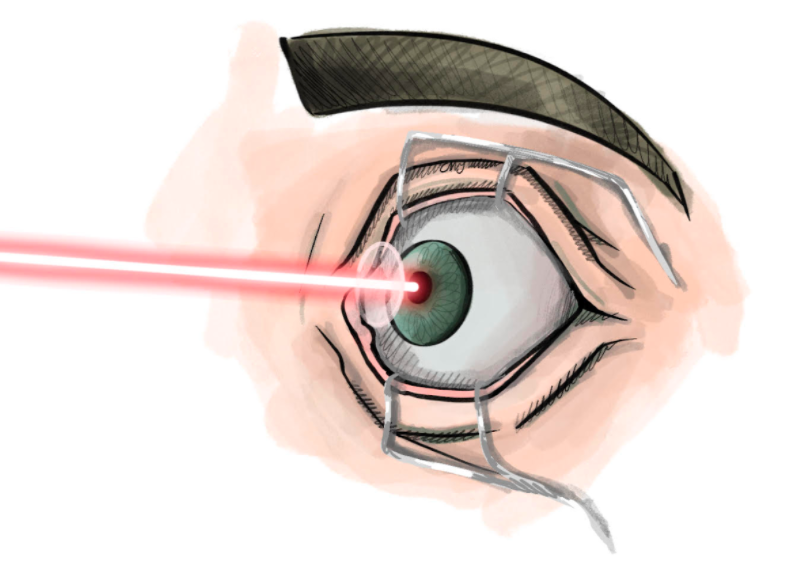LASIK: A Risk Worth Taking?
In the United States, over 61% of the population needs some type of vision correction, whether that be for “nearsightedness” (myopia) or “farsightedness” (presbyopia). Worldwide, that percentage is over 75% for adults. So, it comes to no surprise that an option presents itself to help those who don’t have perfect vision: LASIK eye surgery. But the question is, is it worth it?
What causes bad vision?
Sight is perceived as the reflection of light off of objects reaches your eyes. The human eye is an organ made of several components, all of which contribute to one’s ability to see. The cornea is a transparent, dome-like structure on the front part of the eye, and it is what allows light to enter. After passing through different parts of the eye, the light reaches the retina, a light-sensitive nerve layer that lines the back of the eye. The retina then inverts the information it receives and turns it into electrical signals with the help of special cells called photoreceptors. These electrical signals then travel from the retina to the brain via the optic nerve, where the brain translates the signals into images. Bad vision is generally caused by refractive errors, where the shape of the eye affects and prevents light from focusing directly on the retina. In short, when light is bent incorrectly, the result is blurred vision.
What is LASIK?
LASIK eye surgery involves a visit to an ophthalmologist (an eye/vision care specialist) who will use a laser to reshape the cornea. First, a flap is made in the upper corner, using either a small blade or laser, which is then lifted so that the laser can reshape the deeper cornea by removing a precise amount of tissue. Depending on the vision problem, the location and quantity of tissue removal may vary.
LASIK surgery is conducted when the patient is conscious; to prevent blinking, a small medical device called a lid speculum is used to hold the patient’s eyes open. A topical anesthetic in the form of eye drops is placed in an eye right before the procedure so that the patient doesn’t feel any pain, and the surgery is usually completed in less than 30 minutes. While the concept of having your eye cut open may seem scary and dangerous, the procedure is considered one of the safest elective surgical procedures available, with an estimated complication rate of under 1%.
Pros:
- The technology for LASIK is extremely sophisticated, meaning that errors are unlikely. One such example is the laser itself––the tracking system NASA uses to automate the docking of satellites is used by the LASIK laser tracking platform, which monitors the eyes thousands of times per second and adjusts the laser as needed. If the platform detects any sudden, significant movement from the patient, it will turn off until the patient is safely repositioned.
- A majority of patients experience vision improvement after LASIK surgery, and many have 20/20 vision or better.
- There is less need or no need for corrective lenses such as glasses or contacts, which can be more cost effective in the long-run compared to buying new glasses with new prescriptions each year, or buying more contacts and solution every few weeks or months.
- One will experience more ease in day-to-day life (no more foggy, dirty, and cracked glasses) and more comfort in physical activities such as sports compared to if you wore glasses.
- The procedure is relatively quick, and the recovery time is usually within 24 hours to a few (2-5) days.
- There have been no cases of patients going blind from LASIK
Cons:
- Common side effects include: soreness, dryness, itchiness, light sensitivity, glare, blur. These side effects typically last a few weeks to a few months; though, particularly regarding dry eyes, the symptoms last more than 6 months for 19% of patients.
- Not everybody qualifies for LASIK––some disqualifying factors include being under 18, participating in contact sports where blows to the face and eyes are common, having a disease that affects wound healing, suffering from dry eyes, and having thin corneas.
- LASIK usually costs around $2000-$3000 per eye, and, because it is considered a cosmetic or elective surgery, it is not covered by insurance.
Overall, whether or not LASIK is worth trying is up to the individual, for getting LASIK is a huge decision that requires a lot of time, research, and pondering. If you have any questions about your eligibility, consult a verified medical expert!
Crystal is a junior who is excited to be on The Harriton Banner. Coerced by a suspicious (and lovable) person to join, she soon realized that The Banner...

This is Trinidad Monteagudo Jackson's second year at The Harriton Banner, and is super excited about creating new graphic designs for articles. She...


